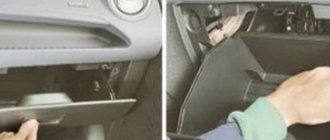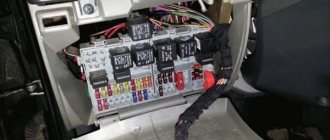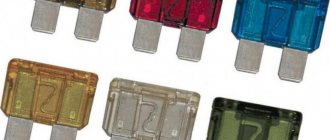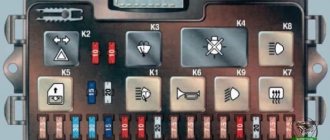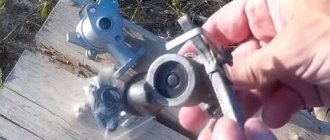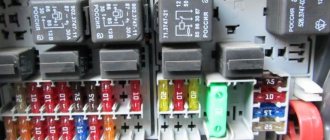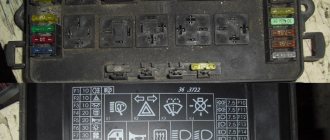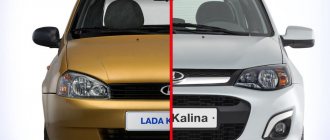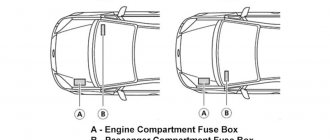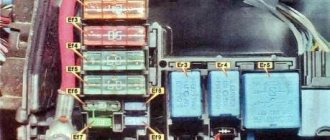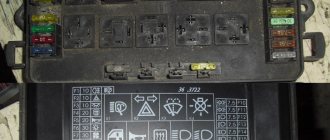Opel Astra H - the third generation of the Opel Astra compact class passenger car, produced in 2004, 2005, 2006, 2007, 2008, 2009 with both gasoline and diesel engines. During this time, the car was restyled. In our article you will find the locations of the control units, a detailed description of the fuse and relay blocks of the Opel Astra h, their diagrams and photo examples of execution. Let's highlight the fuse responsible for the cigarette lighter. In conclusion, we will offer for download complete repair and maintenance manuals for the Opel Astra Ash.
The purpose of the elements in the units of your Opel Astra H may differ from those presented and depend on the year of manufacture, country of delivery and level of electronic equipment.
Block under the hood
It is located on the left side of the engine compartment, next to the pillar and is covered with a protective cover.
Consists of two sections (fuse and relay box and high power power fuse box)
Photo - diagram
Description of fuses
| FB1 | 50A Electro-hydraulic hard top HT |
| FB2 | 80A Diesel (Glow time controller) |
| FB3 | 80A EGUR |
| FB4 | 30A Independent heater IH 100A Additional heater - electric, passenger compartment EH |
| FB5 | 80A at REC/Rear fuse block |
| FB6 | 80A at REC/Rear fuse block |
| F1 | 20A Anti-lock Braking System (ABS) |
| F2 | 30A Anti-lock Braking System (ABS) |
| F3 | 30A Heating system, interior ventilation, climate control (HVAC) |
| F4 | 30A Heating, ventilation and air conditioning (HVAC) system |
| F5 | 30/40A Cooling fan 1* |
| F6 | 30/40A Cooling fan 2* |
| F7 | 10A Window washers 20A (without REC) Central locking ZV |
| F8 | 15A Horn 10A (without REC) Central locking ZV, Windshield washer front, rear WA |
| F9 | 25A Headlight washers 25A (without REC) Heated rear window HFH (K17_X125) |
| F10 | 7.5A To DIAG diagnostic connector |
| F11 | 7.5A Instruments |
| F12 | 5A Circulation pump 7.5A (without REC) Info. ID display, Twin Audio TWA, DAB digital radio, TCV voice control telephone |
| F13 | 15A Fog lights 5A Interior lamp IRL(K18_X125) |
| F14 | 30A Windshield wiper |
| F15 | 30A Door window wiper |
| F16 | 5A Engine control module/Open-Start/Stop system (without REC) ABS-ESP, Horn (K4_X125), Air conditioning, semi-automatic air conditioning, electronic climate control, Stop light switch, el. hydraulic hard top |
| F17 | 25A Fuel filter heating (diesel models) |
| F18 | 25A Starter |
| F19 | 30A Transmission electronics |
| F20 | 10A Air conditioning / Horn (K4_X125) |
| F21 | 20A Engine electronics |
| F22 | 7.5A Engine electronics |
| F23 | 10A Adaptive headlight system (AFL), headlight range control |
| F24 | 15A Fuel pump |
| F25 | 15A Transmission electronics |
| F26 | 10A Engine electronics |
| F27 | 5A Power steering |
| F28 | 5A Transmission electronics |
| F29 | 7.5A Transmission electronics 7.5A (with REC) Automatic/Easytronic transmission control unit |
| F30 | 10A Engine electronics (ignition coils) |
| F31 | 10A Adaptive headlight system (AFL). Headlight leveling 15A (without REC) Rear window wiper (K56) |
| F32 | 5A Brake system fault warning light, air conditioning, clutch pedal switch |
| F33 | 5A Adaptive headlight system (AFL). Headlight level adjustment |
| F34 | 7.5A Steering column module control unit |
| F35 | 20A Infotainment system |
| F36 | 7.5A Mobile phone / radio / Twin Audio system / multifunction display 15A (without REC) Cigarette lighter |
In one of the versions, fuse number 36 at 15A is responsible for the operation of the cigarette lighter. In other cases, look at the block in the luggage compartment.
Relay purpose
- K1 (K11_X125) Radiator fan (FE5, FE6)
- K2 (K12_X125) Radiator fan (FE5, FE6)
- K3 (K7_X125) (with REC) Headlight washer pump (FE9)
- K3 (K17_X125) (without REC) Heated rear window (FE9)
- K4 (K16_X125) (with REC) Fog lights, front (FE13)
- K4 (K18_X125) (without REC) Boot cut-out (interior lighting, etc.) (FE13)
- K5 (K5_X125) Wiper, windshield, low/high (FE14, FE15)
- K6 (K6_X125) Wiper, windshield, ON/OFF (FE14, FE15)
- K7 (K15_X125) Fan, passenger compartment - Air conditioning/heating (FE4)
- K8 (K14_X125) (with REC) Filter heating (Diesel) (FE17)
- K8 (K8_X125) (without REC) Compressor, air conditioning (FE17)
- K9 (K1_X125) Starter (FE18, K3_X125)
- K10 (K13_X125) Radiator fan (FE5, FE6)
- K11 (K8_X125) (with REC) Compressor, air conditioning (FE20, FE32)
- K11 (K4_X125) (without REC) Horn horn (FE20, FE16)
- K12 (K2_X125) Engine control controller (on FE21, FE26, FE32)
- K13 (K10_X125) Fuel pump (FE24)
- K14 (K3_X125) Pin 15 (on K1_X125, FE23, FE24, FE25, FE27, FE29, FE30, FE31, FE33)
Individual relay elements may be located outside the main unit, for example:
- K30A Relay - radiator fan (FE5, FE6)
- K30B Relay - radiator fan (FE5, FE6)
- K84LD/RD Relay - hydraulic unit (convertible top) (FB1)
- K93 Relay - unlocking the gear lever (Automatic transmission AF17/4, AF22/4)
Why are fuses needed for Opel Astra H?
Opel Astra H fuses are needed to open an electrical circuit that has been overloaded. Simply put, if the current in the circuit increases, the fuse blows, and the circuit opens accordingly. This is necessary to prevent a short circuit, which can lead to the breakdown of all electronics in the car, and even to a fire. The block was created for the convenience of the car owner. After all, if fuses were scattered throughout the circuit, it would be very difficult to replace them. Thanks to the fact that they are all collected in one place, you don’t have to search throughout the car to find the one you need.
Block in luggage compartment
Located behind the left interior trim.
Option 1
Scheme
Designation
| 1 | 25/30A Electric drive for controlling front windows |
| 2 | Not used |
| 3 | 7.5A Instrument cluster |
| 4 | 5A Heating/air conditioning/climate control (HVAC) |
| 5 | 7.5A Airbags |
| 6 | Not used |
| 7 | Not used |
| 8 | Not used |
| 9 | Not used |
| 10 | Not used |
| 11 | 25A Heated rear window (tailgate window glass) |
| 12 | 15A Tailgate window wiper |
| 13 | 5A Parking assistance system |
| 14 | 7.5A Air conditioning system |
| 15 | Not used |
| 16 | 5A Seat Occupancy Recognition/Open-Start System |
| 17 | 5A Rain sensor/air quality sensor/tire pressure monitoring system/interior rear view mirror |
| 18 | 5A Devices/switches |
| 19 | Not used |
| 20 | 10A Dynamic Damper Control (CDC) |
| 21 | 7.5A Heated exterior mirrors |
| 22 | 25A Top hatch |
| 23 | 25/30A Electric rear door windows |
| 24 | 7.5A Diagnostic connector |
| 25 | Not used |
| 26 | 7.5A Electric folding exterior mirrors |
| 27 | 5A Ultrasonic sensor, anti-theft alarm system |
| 28 | Not used |
| 29 | 15A Cigarette lighter, front socket |
| 30 | 10A Rear socket for connecting additional electrical appliances |
| 31 | Not used |
| 32 | Open & Start system |
| 33 | Not used |
| 34 | 25A Top hatch |
| 35 | 10A Rear socket for connecting additional electrical appliances |
| 36 | 20A Socket of towing coupling device |
| 37 | 5A Interior lighting |
| 38 | 30A Central locking, pin “30” |
| 39 | 15A Left front seat heating |
| 40 | 15A Right front seat heating |
| 41 | Not used |
| 42 | Not used |
| 43 | Not used |
| 44 | Not used |
- K2 (K3_X131) Relay - heated rear window, mirrors (on FR11, FR21), (from FB5, FB6)
- K3 (K1_X131) Relay - pin 15 (on FR12, FR13, FR14, FR16, FR17, FR18, FR20)
- K4 (K2_X131) Relay - pin 15a (on FR39, FR40)
Fuse number 29 for 15A is responsible for the operation of the cigarette lighter, and fuse number 30 for 10A is responsible for additional sockets.
Option 2
Scheme
Decoding the scheme
| F50 | 10A AC AC (on relay K5) |
| F51 | 15A Fog lights (front) (on relay K39) |
| F52 | 15A Additional socket (rear cigarette lighter) ACS |
| F53 | 7.5A Heated mirrors |
| F54 | 30A Front window regulators FHF |
| F55 | 30A Rear windows FHR |
| F56 | 7.5A Tail lights (on K71), Lock without handle (on K24D) |
| K5 | Relay - compressor, air conditioning (FE33, F50) |
| K24D | Dead lock relay (F56) |
| K39 | Relay - fog lamp, front (F51) |
| K56 | Relay - wiper, rear window (FE31, FE33) |
| K71 | Relay - reverse light (F56, FE33) |
How to identify a malfunction
The Opel Astra H boasts a fairly large number of electrical appliances. Therefore, if one or more of them fails, the first thing you need to do is check the fuses. It will not be difficult to identify a faulty one; in the center it will be blackened, possibly slightly melted, and the metal contact in the middle will be broken. Replacement does not require special fuses specifically for the Opel Astra; this part is universal and inexpensive. The main thing is not to make a mistake with the current strength. The number of amperes will be written on the part itself. In addition, the diagram in the Opel Astra H operating manual and color identification will help:
- The purple part can withstand 3A,
- beige - 5A;
- brown - 7.5A;
- red – 10A;
- blue – 15A;
- yellow – 20A;
- transparent – 25A;
- green – 30A;
- pink – 40A.
Fuses blow out most often due to improper operation of the car. For example, when the windshield or headlight washer fluid freezes, the driver begins to repeatedly press the washer control paddle on the steering wheel. The liquid is not pumped, the electricity in the circuit increases, and accordingly the part burns out. The same result awaits the cigarette lighter if you insert several electrical appliances into it at once, or one that is too powerful. Also, the low beam headlight fuse often suffers because the wrong lamp is used.
The Opel Astra H is a popular model of budget sedans produced by the German concern in the period 2004-2009. This car has gained great popularity in almost all regions of the Russian Federation due to high-quality body assembly and a relatively reliable power unit.
However, for proper operation of the car, it is necessary to maintain the equipment in a timely manner, in particular, monitor the condition of the wiring and correctly change fuses.
Location and layout
The most popular location for fuses is in the interior or under the hood (they are located near the washer). Each car has its own layout, depending on the location (near the cigarette lighter or washer). The diagram is necessary in order to better understand the processes taking place, as well as the principle of operation. Some types of cars (for example, trucks) may have more than one fuse box, or even 4 or 5. They may also be scattered throughout the car, but this rarely happens.
Fuse box in the engine compartment
In the Opel Astra there is not one unit, but two. Their location is in the engine compartment and passenger compartment (near the cigarette lighter). A diagram of the operating processes in the Opel Astra and the elements protected by fuses is located just below.
What is it and why do we need it?
A fuse is a device that protects electricity consumers and electrical circuits from short circuits and system overloads. It contains an insulating body, fuse links, as well as a special terminal that connects the fuse links and the electrical circuit. To avoid overheating, some parts also contain quartz sand.
The fuse box is needed in order to protect the system and prevent fire in case of a sharp increase in current level. This happens due to the fact that they burn out first. Basically, such an element is disposable.
